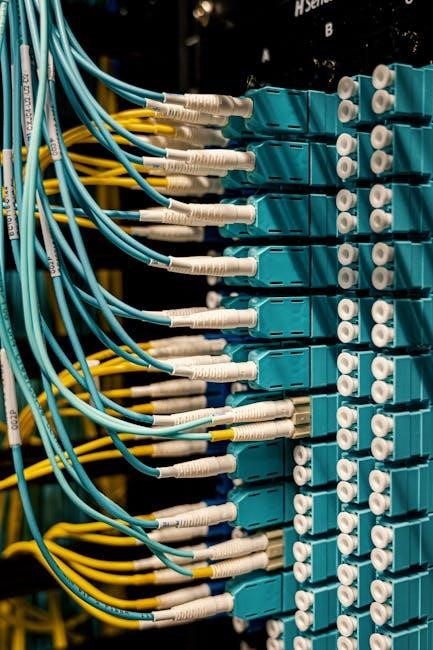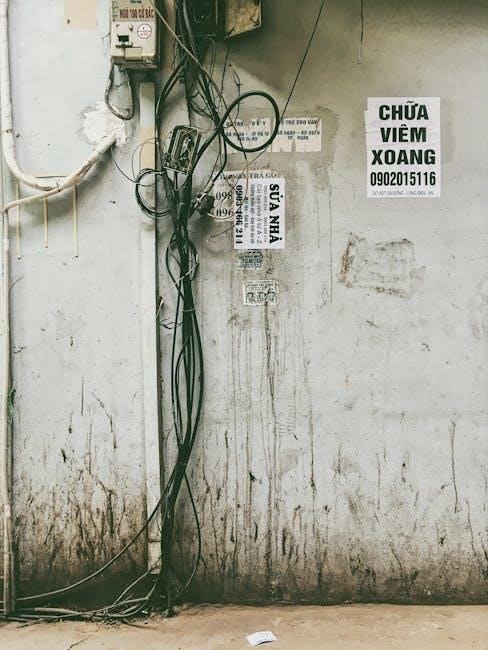Manual transfer switch wiring diagrams are essential for installing backup generator systems, enabling seamless power transitions between utility grids and generators using
specific
protocols always.
Importance of Understanding Wiring Diagrams
Understanding wiring diagrams is crucial for the safe and effective installation of manual transfer switches. A wiring diagram provides a visual representation of the electrical connections between the switch, the power source, and the load. By studying the diagram, installers can ensure that the switch is connected correctly, reducing the risk of electrical shock, fires, and other hazards. The diagram also helps installers to identify the correct wires, terminals, and connections, making the installation process faster and more efficient. Furthermore, understanding wiring diagrams enables installers to troubleshoot problems and perform repairs more easily. The internet provides a wealth of information on manual transfer switch wiring diagrams, including diagrams for different amp models and types of switches. By consulting these resources, installers can gain a deeper understanding of the wiring diagram and ensure a successful installation. This knowledge is essential for anyone working with manual transfer switches.

Components of a Manual Transfer Switch
Manual transfer switches consist of electrical contacts, actuators, and
housings
that facilitate power transfer between sources always safely.
Power Source and Load Sections
Wiring diagrams for manual transfer switches are typically divided into two sections: the power source and the load. The power source section connects to the utility grid or generator, while the load section connects to the electrical panel or circuit breaker. This division allows for safe and efficient transfer of power between sources. The power source section typically includes a male end receptacle specifically designed for generators, which provides a secure and weatherproof connection. The load section, on the other hand, connects to the electrical panel or circuit breaker, distributing power to the various circuits and appliances. Understanding the power source and load sections is crucial for proper installation and functioning of the manual transfer switch. By following the wiring diagram, electricians can ensure a safe and reliable connection between the power source and the load, enabling seamless transfer of power during outages or maintenance. Proper installation is essential for safety and efficiency.

Types of Manual Transfer Switches
Manual transfer switches include single-pole, double-pole, and three-pole switches, each with unique configurations and applications always using specific
protocols
.
Single-Pole, Double-Pole, and Three-Pole Switches
Single-pole switches are commonly used for simple applications, while double-pole switches offer more complexity and three-pole switches provide the highest level of control, each with its own wiring diagram requirements.
The main difference between these switches lies in the number of poles, which determines the number of circuits that can be controlled.
Single-pole switches have one pole, double-pole switches have two poles, and three-pole switches have three poles, allowing for increased flexibility and customization.
Understanding the differences between these switches is crucial for selecting the correct switch for a specific application and ensuring proper installation and wiring.
Additionally, the type of switch used will impact the overall performance and safety of the system, making it essential to carefully consider the options and choose the most suitable switch.
By considering the specific needs of the application and selecting the correct switch, individuals can ensure a reliable and efficient system that meets their requirements.
Overall, single-pole, double-pole, and three-pole switches each have their own unique characteristics and uses, and understanding these differences is essential for working with manual transfer switch wiring diagrams.

Wiring Diagrams for Different Amp Models
Reliance offers wiring diagrams for various amp models, including 30, 40, 50, and 60-amp switches, providing essential information for installation using specific
protocols
and guidelines always.
Reliance Manual Transfer Switch Wiring Diagrams
Reliance manual transfer switch wiring diagrams are available for different amp models, including 30, 40, 50, and 60-amp switches. These diagrams provide essential information for installing and wiring the transfer switch correctly. The diagrams include detailed illustrations of the switch’s components and wiring connections, making it easier to understand and follow the installation process. Reliance also offers a range of resources, including user manuals and instructional videos, to help with the installation and troubleshooting of their manual transfer switches. By following the wiring diagrams and instructions provided by Reliance, users can ensure that their manual transfer switch is installed and functioning correctly, providing a reliable and safe source of power during outages. The diagrams are also useful for electricians and technicians who need to install and maintain the switches. Overall, Reliance manual transfer switch wiring diagrams are an important tool for anyone installing or using a manual transfer switch. They provide clear and concise information, making it easier to get the job done.

Installation and Safety Considerations
When installing a manual transfer switch, it is essential to follow proper safety protocols to avoid electrical shock or injury. The switch should be installed by a licensed electrician who is familiar with the wiring diagram and local electrical codes. The installation process involves connecting the switch to the generator, utility grid, and load center, and ensuring that all connections are secure and meet safety standards. It is also crucial to test the switch before putting it into operation to ensure that it is functioning correctly. Additionally, the switch should be installed in a location that is easily accessible and protected from the elements. Regular maintenance and inspection of the switch are also necessary to ensure that it continues to operate safely and efficiently. By following these installation and safety considerations, users can ensure that their manual transfer switch is installed and functioning correctly, providing a reliable and safe source of power during outages. Proper installation is critical to safety and efficiency.